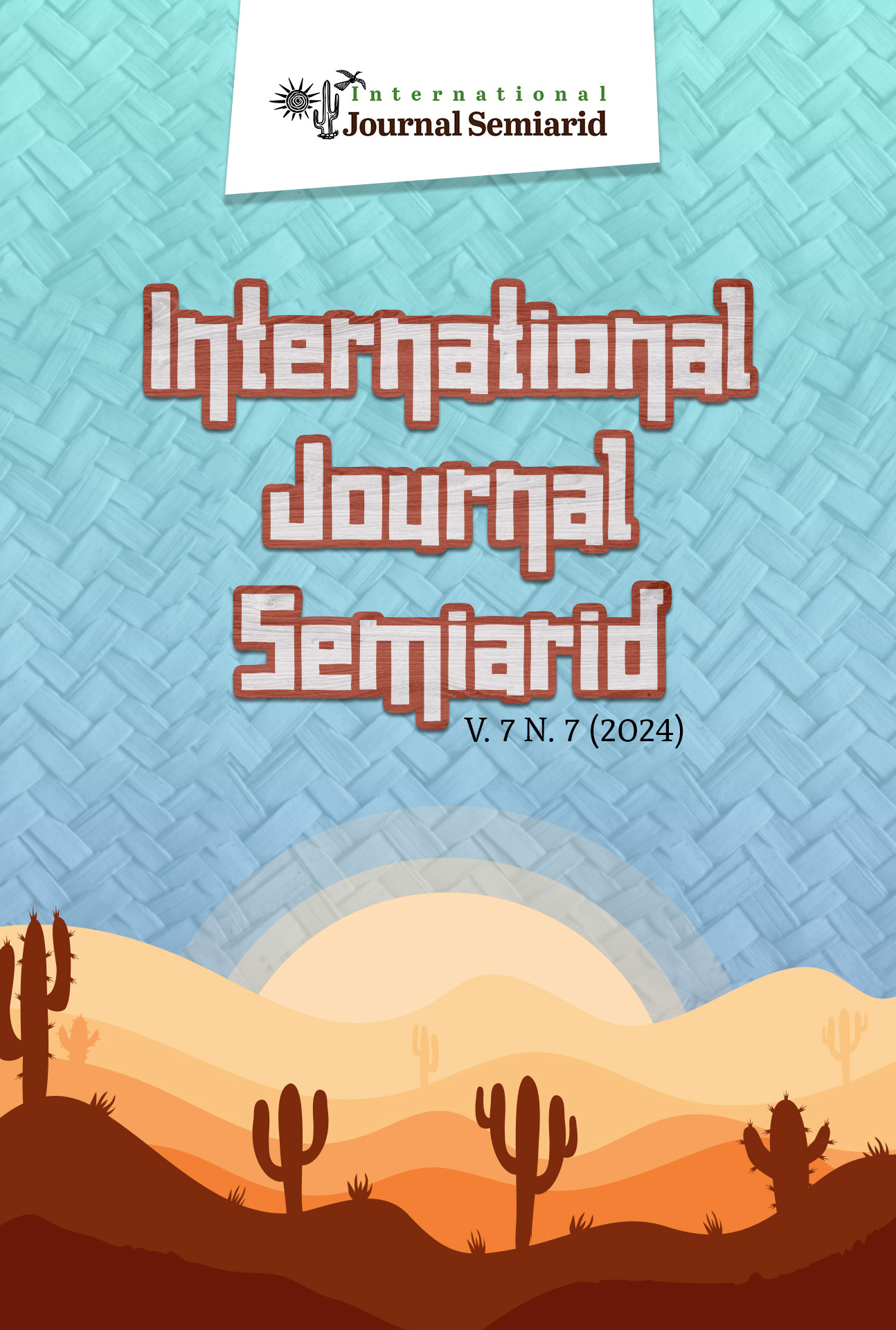EVALUATION OF DEGRADATION OF VEGETABLE COVER IN THE MUNICIPALITY OF TRINDADE-PE
DOI:
https://doi.org/10.56346/ijsa.v7i7.192Keywords:
DEGRADATION OF VEGETABLE, Flona of AçuAbstract
The caatinga is a plant formation that occurs in the northeast region of Brazil, located over an area of depression, its reliefs are composed of to a huge rocky outcrop mostly composed of crystalline rocks, some plateaus in the case of the inselbergs that in allusion to the ice iceberg this refers Borborema Plateau, several plateaus such as those of Araripe/Ibiapaba composed of sandstone rocks, depending on the location and topography, humid environments such as high-altitude swamps and or islands of Atlantic forest may arise in the case of the Araripe plateau. The soils of the morphoclimatic domain of the caatingas are generally shallow soils with the presence of rock outcrops in several regions, in these environments the caatinga vegetation is composed in a more stunted way, sometimes without arboreal individuals on the landscape but a notorious presence of cacti in its vegetal composition, in environments where the presence of well-developed soils occurs, the most arboreal formations of the vegetation can be observed, in the case of Araripe in Pernambuco, which is the region where the municipality of Trindade-PE is located, it presents several physiognomies not only from arboreal caatinga but also from savannahs, in this case the carrasco, which would refer to the dense vegetation at the top of the Chapada do Araripe in the state of Pernambuco, several areas of seasonal deciduous forest, this formation being classified as part of the Atlantic forest and in a more restricted way. those considered to be carnauba paths generally close to lagoons and intermittent streams. This article aimed at evaluating the degradation of vegetation cover in the municipality of Trindade-PE, presenting topographic data, historical rainfall, and hydrography and among other characteristics that contribute to plant behavior. Something also analyzed as a factor of change in the natural land cover is human activity being carried out through agricultural, urban or industrial activities, which in the case of the studied area is the mining of gypsum, a raw mineral extracted from the earth. However, improper use can be harmful, causing damage to the environment and impacting the economy, as it reduces the ability to regenerate new nutrients for new food productions.
References
AB’SÁBER, Aziz. Os domínios da natureza no Brasil: potencialidades paisagísticas. São Paulo: Ateliê Editorial, 2003.
AGÊNCIA ESTADUAL DE PLANEJAMENTO E PESQUISAS DE PERNAMBUCO (CONDEPE/FIDEM). Origem cristalina e relativamente sobre afloramentos sedimentares, 2008.
ALVES, E. D. L. MENDONÇA, F.; DANNI-OLIVEIRA, I. M. Climatologia: noções básicas e climas do Brasil. Sociedade & Natureza, v. 22, n. 3, 2011, p. 2007. 206.
ANDRADE, K.V.S.A.; RODAL, M.J.N.; LUCENA M.D.F.A. & GOMES A.P.S. Composição florística de um trecho do Parque Nacional do Catimbau, Buíque, Pernambuco - Brasil. Hoehnea v.31, 2004, p.337-48.
ARAÚJO, F.S.; MARTINS, F. R. Fisionomia e organização da vegetação do carrasco no Planalto da Ibiapaba, estado do Ceará. Acta Botanica, v.3, 1999, p.1-13
ARAÚJO F.S.; COSTA, R. C.; LIMA, J. R.; VASCONCELOS, S. F.; GIRÃO, L. C.; SOUZA SOBRINHO, M.. Floristics and life-forms along a topographic gradient, central-western Ceará, Brazil. Rodriguésia v.62, 2011, p.341-66.
AUGUSTO, L. G. S.; GÓES, L. Compreensões integradas para a vigilância da saúde em ambiente de floresta: o caso da Chapada do Araripe, Ceará, Brasil. Cad. Saúde, v.23, 2007. BRASIL. Área Territorial: Área territorial brasileira 2020. Rio de Janeiro: IBGE, 2021.
CARVALHO, Claudio J. B. de Biogeografia da América do Sul : padrões e processos / Claudio J. B. de Carvalho, Eduardo A. B. Almeida. – São Paulo : Roca, 2010
CAVALCANTI, L. C. de S. Cartografia de paisagens: fundamentos / Lucas Costa de Souza Cavalcanti. – São Paulo: Oficina de Textos, 2014.
GOMES RUBIRA, F. Definição e diferenciação dos conceitos de áreas verdes/espaços livres e degradação ambiental/impacto ambiental. Caderno de Geografia, vol. 26, núm. 45, 2016, pp. 134-150.
GRAEFF O. (2015) Fitogeografia do Brasil uma atualização de bases e conceitos. Editora: Nau, Rio de Janeiro. ISBN 9788581280431.
LYRA, L. de H. de Barros. 2003; Analise Geo-Ambiental da área de Brejo na Serra Das Varas, Arco Verde-PE, Orientador: Dra. Cristina Crispim, 2003. 127 f. TCC- Curso de Geografia, Universidade Federal da Paraíba, João Pessoa, 2010.
PAIVA, C. D. G; MORO, M. F.; SOUSA, L. O. F.; BALDAUF, C. Fitossociologia da caatinga na Floresta Nacional de Açu, Estado do Rio Grande do Norte, Brasil e entorno: diversidade e biogeografia do componente lenhoso. Hoehnea, v.48, n.1 ., 2021. DOI: https://doi.org/10.1590/2236-8906-22/2020
PENNINGTON, R.T.; PRADO, D. E.;. PENDRY, C. A. Neotropical seasonally dry forests and Quaternary vegetation changes. Journal of Biogeography, v.27, n. 2, 2000, p. 261-273. doi:10.1046/j.1365-2699.2000.00397.x
SÁ, I.B.; FOTIU, G.A; RICHÉ, G.R. 1994. Degradação ambiental e reabilitação natural no trópico semi-árido. In: Anais Conferência Nacional e Seminário Latino-Americano da Desertificação, CONSLAD. Fundação Esquel Brasil, Fortaleza, CE.
SÁ, I. I. S.; GALVÍNCIO, J. D.; MOURA, M. S. B.; SÁ, I. B. Avaliação da Degradação Ambiental na Região do Araripe Pernambucano Utilizando Técnicas de Sensoriamento Remoto. Revista Brasileira de Geografia Física 06 (2011) P.1292-1314.
SAINT-HILAIRE, A.; BRANDÃO, M. G. L.; PIGNAL, M. (Orgs.); 2009. Plantas usuais dos brasileiros. tradução de C. P. B. Mourão e C. F. Santiago. Código Comunicação, Belo Horizonte. Disponível em http://www.ceplamt.org.br/wp-content/uploads/2014/02/Plantas-usuais-dos-brasileiros.
SILVA, J. P. S. Impactos ambientais causados por mineração. Revista Espaço da Sophia, n.8, 2007.
SOUZA, C. ., SANTOS, F. ., CUNHA, I. ., MENEZES, M. ., & ARAÚJO , T. . (2008). A DEGRADAÇÃO DA COBERTURA VEGETAL DO MUNICÍPIO DE VITÓRIA DA CONQUISTA – BA. ENCICLOPÉDIA BIOSFERA, v.4, n.6, 2008.
VELLOSO, A. L.; SAMPAIO, E. V. S. B.; PAREYN, F. G. C. Ecorregiões propostas para o bioma caatinga. Recife: Associação Plantas do Nordeste; Instituto de Conservação Ambiental, The Nature Conservancy do Brasil, 2002. 76 p


